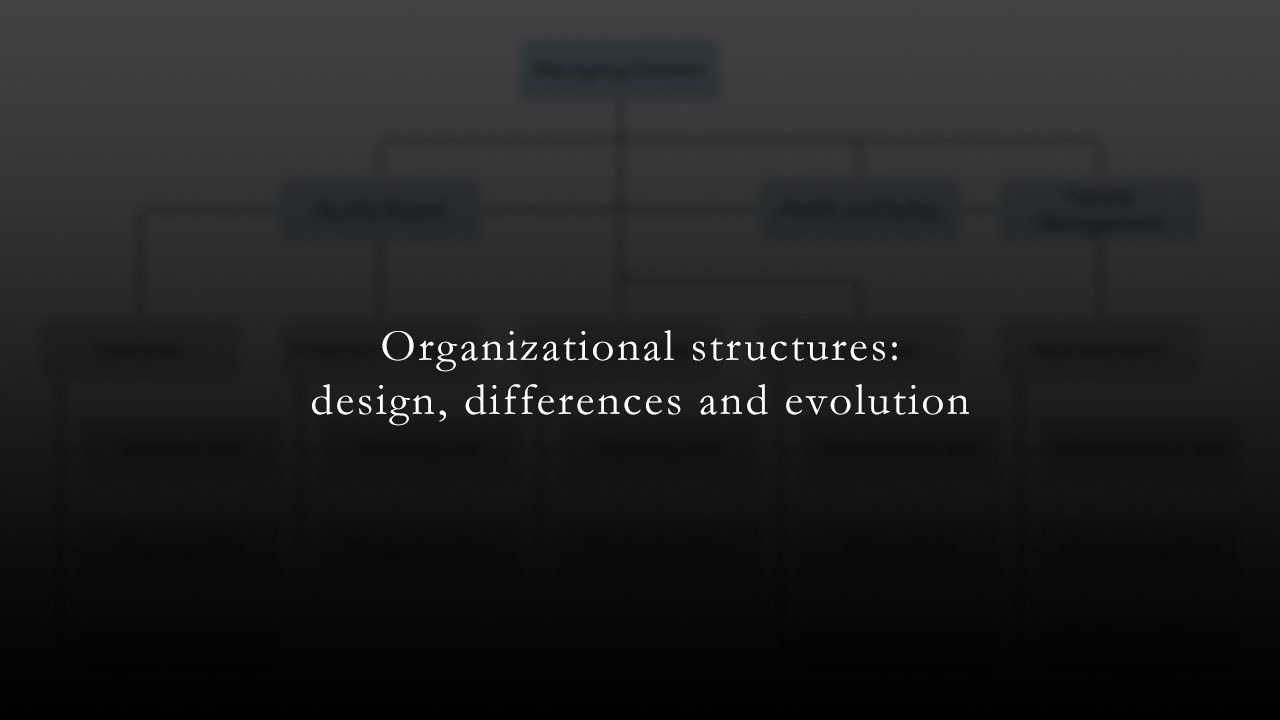Introduction
Organizational design can not overlook efficiency and effectiveness outcomes. Bearing in mind span of control, specialization and levels of authority too, we are going to analyze organizational structures and if there is one better than other to achieve a stronger performance. The excursus considers differences between forms, including pros and cons, not forgetting the likely evolutions in light of current scenarios. Indeed, the perfect model is what continuously best fit the company.
Table of Contents
- Introduction
- Organizational structure and design
- Design in practice: adapting structure to the company
- How organizational structures differ
- The evolution of organizational structures
- Conclusions
- References
Organizational structures and design
Structuring organizations is dynamic, it isn’t a one-shot choice, due to the innate behavior of the company to be contingent in relation to time and space. In this sense, the organizational model suffer the event flow – internal and external – and maintain validity only if it’s designed on flexible tracks.
The structure is in the service of the function.
Underestimate social and economic researches could be risky: if the organization performed well last decade, this do not means tomorrow will be the same. Today, we need extremely lean organizational structures in order to jump off from the competitive holes. Design should balance informal coordination with standardization, flexibility and rigidity, unexpected and expected. Indeed, formal and informal structures are often indistinguishable (Galbraith, 1973).
Obviously, the support of a skilled change management team is crucial to encourage dynamism. Moreover, continuous innovation could be useful in order to consider the change as normal. Avoiding solidifications in tasks, roles or responsibility lines should be part of the company culture.
Hence, why organizational structures are important? Simply because a constant coherence between structure designed and strategy implies an optimized company’s general performance.
Design in practice: adapting structure to the company
Firstly, dimension is not the main variable about design. A quite large B2B company (in number of employees or turnover), could be arranged into a simple functional model with direct supervision or work standardization and achieve a great setup to perform effectively. Actually, the decision maker has to bear in mind internal factors (strategy, culture and workforce in primis) and external factors (market trends, laws).
Besides, Business process management (BPM) represents a valid support when processes and/or automations are massive, idem about Human Resources Management System (HRMS).
During the design process, the decision maker has to exploit its overall view of the company, because the coherence goal goes from finding synergies between people, tasks, roles, teams and responsibility lines. This does not means that designing is hierarchical process, in fact bottom-up inputs (e.g. operators) or external inputs (e.g. advisory agency) are priceless. Thus, we have to ask ourselves: “Which configuration better joins the company?”, “Can I deploy this model or is it better to adopt before a middle version of the final structure?”, “How long will this structure be valid? Can I estimate its life cycle?”.
How organizational structures differ
Basically, there are five main organizational structures with different pros and cons:
- Simple model;
- Functional model;
- Divisional model;
- Matrix model;
- Adhocratic model.
Simple structure
Typical of entrepreneurial situations and young SMEs, the simple structure has a loose division of labour, lack of planning and control, conservative approach, poor innovation and little technostructure (Khandwalla, 1977). The decision maker tends to coincide to the CEO. A small business can surely benefit from this configuration, but it has to change with growth without condemn itself to nanism.
Functional structure
Here, complexity grew up and the designer is focusing about standardization. That is where corporate functions come. Actually, we have to distinguish:
- Machine bureaucracy: where standardization of work processes is predominant, along with functional grouping, vertical centralization and stable environment. Technostructure represents the key part of the organization (e.g. a hotel, a steel company, an airline).
- Professional bureaucracy: where standardization of skills is predominant, along with horizontal job specialization, decentralization and stable environment. Operators represent the key part of the organization (e.g. a school or a general hospital, a healthcare center).
Divisional structure
Direct consequence of diversification, the divisionalized form focus on results, better on standardization of outputs. That is where divisions come: product/service, customer type/target, area/geo etc., theoretically any kind of business cluster could be adopted. The divisional model does not necessary origin from a functional configuration (Rumelt, 1974), but it can happen, mostly in the mature stage of the company lifecycle (ed.). In truth, we can find machine bureaucracy implications here too (the real market do not completely match these sharp classifications).
In the divisionalized form, middle line managers and the performance-oriented approach are crucial. Often, in fact, Management by Objectives (MBO) can solve usual issues related to divisions: high centralization, internal competition, social silos and exponential costs due to the functions’ duplication.
Matrix structure
This hybrid form is a result of plural strategic prompts.
It is not unusual that companies need to benefit both from functions and divisions. These situations can assume a temporary nature (e.g. several important projects) or a permanent nature (e.g. several innovative products). The matrix structure reflects a high competitive environment, willingness to innovate, flexibility. Here, the decision maker could move people from different functions to key teams responsible for a project or a service and in this way, we can assume “two-boss” employees (project/product and related division). Clearly, especially in this case, the organizational structure has to be grown progressively and not simply set up. For this scope, integrator managers act as change facilitators.
The challenge is to set up the matrix in the managers’ mind and not the matrix adoption itself.
Adhocratic structure
Think about a product-market combination with a innate variance and continuous innovation: what structure does give the company conditions to perform at its optimum?
The Adhocracy takes advantage of considerable decentralization, bottom-up approach, minimum formalization, heavy training, mutual adjustment and horizontal job specialization. The support staff plays a key role in the Adhocracy: together with the line managers, they form the central pool of expert talent from which the project personnel are drawn (Mintzberg, 1981).
Often, the company apex do not spend excessive resources in strategy development: rather, the bottom-up approach allows teams to formulate strategy. Examples of Adhocracy are NASA, UNICEF or Wikipedia.
Interested in learning more about Adhocracy Culture and how it can help organizations thrive in the current business landscape?
We invite you to read our detailed article about adhocracy, which delves into the intricacies of this innovative approach and its potential benefits.
The evolution of organizational structures
Discussing in terms of evolution is quite improper due to the natural dependency role of organizational models: they change according to company’s lifecycle stage, so their evolution is strictly related to the specific company and it is not expressible at a theoretical level.
Actually, we can notice a conveyance towards hybrid configurations. The idea is to gain an environment useful to maximize knowledge flows inter and intra units, maintain flexibility in the long-run and encourage innovation at each level (with bottom-up forces included). Modulate delegation and responsibility is a goal too, indeed polar forms have been progressively adopted by a number of companies: this structure allows to go beyond the usual and strict hierarchical management system. A further interesting configuration is the Kotter’s “Dual Operating System”, where hierarchy and network are merged in order to seize opportunities and manage risks (Kotter, 2015).
On the other hand, there is a multitude of companies getting excellent results with the (not) old-fashioned functional structure or with a product-divisional form too. The reason lies in the fact that models above discussed are not sorted by complexity, stages, date or something that suggests an order or a kind of evolution: they has to vary according to the company (and not vice versa). The only evolution plausible is parallel for each structure, in order to be aligned to the companies’ lifecycles, strategies and latest market trends.
Conclusions
At this point, it is undisputed the ongoing process related to the organizational design, the fine tuning and the crucial role of people along with the organizational culture. The human capital gain is achieved by a fitting form too, but bearing in mind that the five organizational models – Simple, Functional, Divisional, Matrix, Adhocracy structure – represent a theoretical abstraction of the reality, that is not attributable to a singular form. The bottom-up pushes are getting stronger and the decision maker – maybe prompted by the governance – does not has to fall into the trap of chasing a strictly and idealistic match between model and reality.
References
GALBRAITH, J. K., and EDSTROM, A. (1976). Creating Decentralization Through Informal Networks: The Role of Transfer. In R. H. Kilmann, L. R. Pondy, and D. P. Slevin (Eds), The Management of Organization Design (Vol. 2, pp. 289-310). New York, NY: American Elsevier Publishing.
KHANDWALLA, P. N. (1977). The Design of Organizations. New York, NY: Harcourt Brace Jovanovich.
KOTTER, J. P. (2015). The Organization of the Future: A New Model for a Faster-Moving World. In Kotter. J. P. (Eds), Reinventing the Company for the Digital Age (pp. 9-10). Bilbao: BBVA.
MINTZBERG, H. (1979). The Structuring of Organizations. New Jersey: Prentice-Hall.
RUMELT, R. P. (1974). Strategy, Structure and Economic Performance. Harvard: Division of Research, Graduate School of Business Administration, Harvard University

